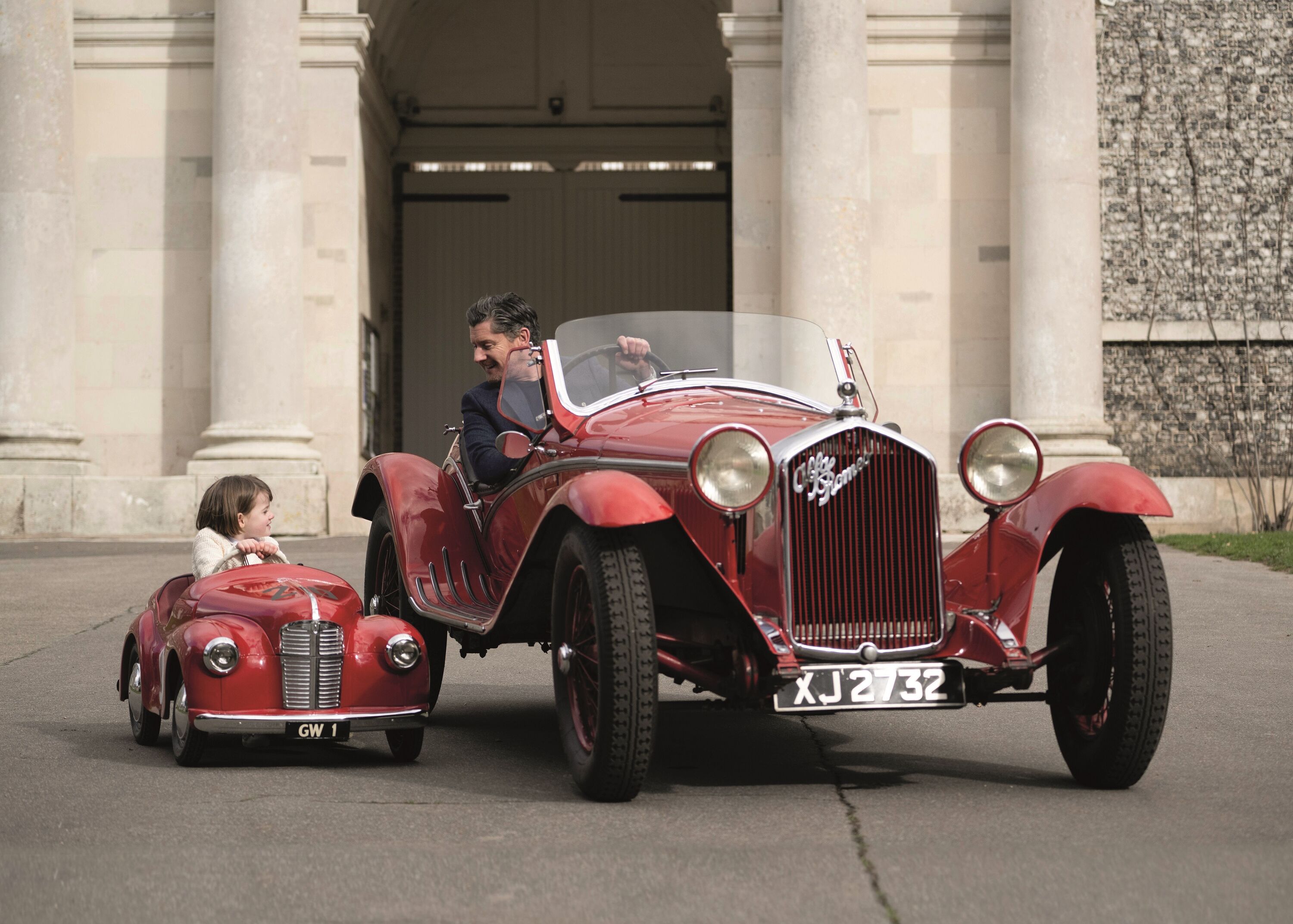Axon's Automotive Anorak: Pininfarina's underrated designs
A few weeks ago, my GRR colleague and regular columnist Andrew Frankel’s views fascinated me on his personal top ten favourites by the Turin automotive design specialists, Pininfarina.

You can read that here… I have long been a huge admirer of the fine automotive artistry of Pininfarina, which for me have always surpassed all of Italy’s other talented car styling houses for discrete elegance and consistency, including the gifted Zagato, Michelotti and Ital Design.
Whilst I concur with most of Andrew’s top ten Pininfarina choices (especially the 1971 Ferrari 365 GTC/4 and 1988 Alfa Romeo 164, but less so the 2009 Ferrari 458), I was surprised to see that he chose nothing earlier than the (Ferrari) Dino 206 GT of 1967.
By the time the seductive mid-engined Dino came along, Pininfarina had already been styling and building an astonishingly diverse and elegant range of vehicles, with the late-1940s to mid-1960s widely being regarded as the heyday of the Torinese designer’s art and achievements.
So, below are another eight Pininfarina greats to add to Andrew’s post-1967 top ten, with most of my selection pre-dating the Dino from Pininfarina’s halcyon days, including three of the Company’s most widely-acclaimed and influential car designs of the 1950s. Like Andrew, all but one of the Pininfarina masterpieces I have selected includes just one concept car.
1947 Cisitalia 202 GT
It is astonishing to think that more than a year before us Brits had even been exposed to the then still top-secret new Austin A70 Hampshire, Triumph Renown, Vauxhall Wyvern, (cue sharp intake of breath) Morris Minor, and other British motoring stodge, Pininfarina had already launched its seminal Cisitalia 202 GT at the 1947 Villa d”Este Gold Cup . The simple yet aesthetically pleasing Cisitalia is an exceptional example of pure rolling sculpture; one of the most influential works of post-war automotive design, influencing car design for many decades to follow with its smooth flowing curves, fastback profile and no sharp edges, conveying a sense of speed, with no running boards to be seen (still a common car feature in 1947!). To honour the Cisitalia’s striking simplicity, beauty and modernity, an example of this Pininfarina masterpiece was displayed in the New York Museum of Modern Art in 1951; the very first time a motor car had even been given such important recognition.
1950 Lancia Aurelia B20 Coupe
Pininfarina’s elegant fastback 2+2 Lancia Aurelia B20 Coupé is commonly regarded as the car that introduced the Gran Turismo GT concept to the world. With its flowing, graceful lines, the Aurelia B20 evolved the earlier Cisitalia 202’s elegant and timeless design, with a longer wheelbase and an even more harmonious single-unit form to really help establish the Turin styling house as the go-to design consultant post-war. This Lancia was an object lesson in good taste and class in the early 1950s, aided by the superbly-engineered Aurelia’s fine chassis and powerful engine combination, making it a powerful force in competition.
1951 Ferrari 212 Inter Cabriolet
This handsome 212 Inter Cabriolet (chassis no. 0177E) is a very significant car for both Ferrari and Pininfarina. Revealed at the 1951 Brussels Salon, this elegant 212 Inter is the first Ferrari to be bodied by Pininfarina; a very important move for the Turin company which went on to enjoy a long and fruitful relationship with the revered Maranello sports car maker, only recently severed through Ferrari now styling its latest models in-house. With Enzo Ferrari initially favouring the design work of Touring of Milan and Vignale in his young Firm’s early years, this 212 Inter was to prove highly formative for him and Pininfarina (with its aggressive oval cheese grater grille, subtle flowing coachwork, and so on), with Il Commendatore switching his elegance from Touring, Vignale and Zagato, et al, to Pininfarina almost instantly.
1957 Lancia Flaminia Coupe
Another Lancia-based Pininfarina design of major importance, the exquisite Flaminia Coupe (along with its statelier Berlina four-door sister) were the final production incarnation of the delicious and far-sighted Pininfarina Florida and Florida II concept cars of the mid-1950s. The Flaminia set the form for a number of subsequent Pininfarina-styled mass-produced and commercially successful saloon models, such as the BMC Farinas, the Peugeot 404 and Fiat 1800-2300 series. Said to be the personal favourite of all of the many cars created by Battista ‘Pinin’ Farina, the founder of Carrozzeria Pininfarina, the long and low Flaminia Coupe predicted the measured, subtle style for which the Turin coachbuilder built a reputation in subsequent years, the Lancia’s elegant DNA reappearing in later large four-seater coupes, from the Ferrari 365 GT 2+2 and 400i, the Peugeot 504 and 406 Coupes, the sublime Fiat 130 Coupe, and 2+2 Lancia Gamma and Rolls-Royce Camargue. That’s quite some legacy.
1966 IKA-Renault Torino
From designing a number of previous Nash models for the North American market in the 1950s (including the bathtub-like Nash/Austin Metropolitan!), the AMC group retained the design services of Pininfarina into the 1960s, with the Italians assisting in the styling of the popular Rambler American compact models. The unusually refined (by contemporary US standards) Pininfarina-influenced styling of the third-generation 1964-69 Rambler American, was ironically reworked in Turin for the Argentinian version, built locally by IKA (and later Renault Argentina) and named Torino. With a long production cycle of 25 years and drilled into the affections of every Argentinian motoring enthusiast, the Torino morphed into a Renault in 1975, with the design skills of Pininfarina retained to help keep the model looking less overtly USA, and up to date, fresh and desirable. It succeeded!
1971 Fiat 130 Coupe
Arguably Pininfarina’s greatest styling work for a production car of the 1970s (a bold statement given its other excellent styling for the Ferrari Berlinetta Boxer and Lancia Gamma Coupe too), the Fiat 130 Coupé was, and remains, an absolute masterpiece. Drawing on the heritage of the equally exquisite 1950s Lancia Flaminia Coupe, Fiat’s mid-1970s flagship model was a lesson in scalpel-sharp, straight-edged purity of form, the 130’s stunning elegance winning countless international design awards, and moving Pininfarina’s design language on to its next, sharper phase from its years influenced by the Flaminia’s success. The Paolo Martin-penned Fiat cleverly spawned the Pininfarina Maremma concept car in 1974 (a ‘shooting brake’ prototype) and the Opera in 1975 (a four-door saloon version), proving the excellence and fundamental ‘correctness’ of this design. The Fiat 130 Coupe is a true masterclass in minimalist elegance, and in my view, one of the most beautiful and significant car designs of the last 50 years. It’s simply sublime!
1976 Pininfarina Peugette 104
Andrew Frankel indulged his top Pininfarina selection by choosing one none-production car, so I have done the same and opted for the charming, fun-loving Peugeot 104-based (another great Pininfarina design) Peugette sports car concept. This minimalist 1976 prototype was intended to revive the concept of a small, affordable two-seater roadster, in the style of an MG TD, Midget, Triumph Spitfire and Fiat 850 Spider. To keep costs and production methods down, the Peugette craftily utilised all symmetrical plastic body panels, left to right and front to back. Thus, the front and rear bonnet/boot and wings were interchangeable, as were the doors, with the simple dashboard using modular instrument ‘pods’ to cut down on parts and costs. All very clever, but sadly all to no avail either, as Peugeot had recently taken over Citroen, and had little time and money to spare for such ‘fripperies.’ Our loss.
1997 Peugeot 406 Coupe
Despite a few interesting and dramatic vehicle designs throughout the 1980s (e.g. the Ferrari Testarossa and 288 GTO, plus the classy Alfa Romeo 164 and Peugeot 405), Pininfarina’s knack of creating gorgeous and timeless designs slightly eluded the Turin styling house for a few years. This dry patch thankfully came to an end though in 1997 when the Pininfarina designed Peugeot 406 Coupe hit the streets with its lusciously pleasing and timeless elegance. Guaranteed to be a future classic, the svelte 406 Coupe is sadly the final Peugeot to be both styled and built by Pininfarina, the French vehicle maker subsequently turning its back on Turin to design its own (usually less appealing and sometimes challengingly-styled) cars! A loss to both Pininfarina, Peugeot and us new car buyers.
axon's anorak
axon's automotive anorak
pininfarina













